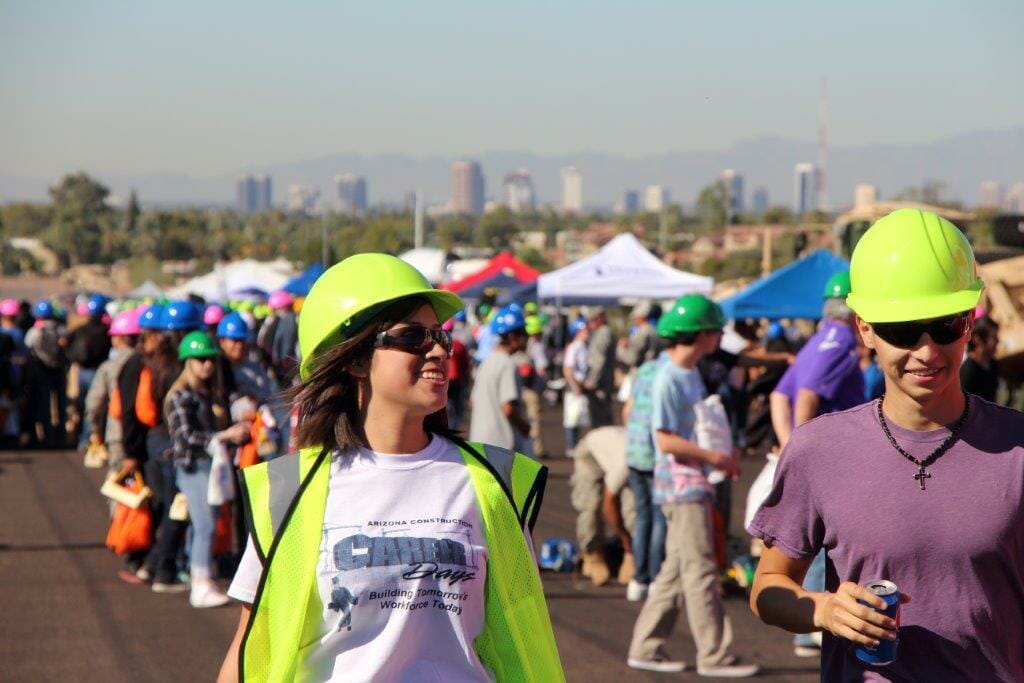Without stone, sand and gravel — otherwise known as aggregates — modern life would be significantly different. Aggregates are the literal building blocks of everyday staples from concrete and cement to bridges, houses, schools, medical facilities — pretty much any building — and on and on the list goes. As crucial to modern society as aggregates are, so is the aggregate workforce that mines, processes and produces them.
READ ALSO: Arizona mining industry steps up to meet skyrocketing demand for copper
A diminished aggregate workforce could have far-reaching impacts on Arizona’s overall economy and infrastructure. Knowing this, many educational institutions are doing their part to build and ensure a steady aggregate workforce pipeline — from The University of Arizona (UArizona) and Arizona State University (ASU) to East Valley Institute of Technology (EVIT), West-MEC, Arizona’s community college system, Association for Construction Career Development (ACCD).
Between a rock and a hard place
One significant problem in perpetuating a healthy aggregate workforce is outdated perception. Many educational leaders agree, that in addition to basic lack of knowledge about the importance of aggregates, many people — particularly students — hold old and incorrect ideas related to aggregate career paths.
The truth is aggregate is big business in Arizona. And a pivotal piece of the economy.
According to the Arizona Rock Product Association (ARPA), Arizona was the No. 2 producer of non-fuel minerals in 2020, produced approximately $8 billion worth of all non-fuel minerals in the U.S. — with the principal minerals being copper, molybdenum, sand & gravel, cement and stone — and houses 560 rock products facilities.
“The challenges around attracting people to aggregates are similar to the challenges we have generally in attracting people to mining,” says Kray Luxbacher, department head of mining and geological engineering at UArizona. “We’re always asking prospective students: Do you want to work on the largest automation projects on the planet?”
Adds Lauro Rivas, director of quality control at CalPortland Company Southwest Materials Division. “The first question I ask when I go as a guest speaker [to schools] is how much aggregate is in one cubic yard of concrete? [The answer] you need 1.6 tons per every cubic yard of concrete.”
When students and labor contenders are exposed to educators and professionals like Luxbacher and Rivas, they’re able to gain an expanded, more accurate conception of why aggregates are essential as well as the breadth of careers available.
Luxbacher goes on to explain that because the aggregate industry is changing rapidly — much like the mining industry — more jobs and diversified opportunities are emerging.
For example, the aggregate sector is increasingly adopting automation as well as safety efficiency and productivity — especially decarbonization — Luxbacher notes. “The aggregate industry still needs people like equipment operators, skilled mechanics, electricians, engineers and geoscientists,” she says. “But now they also need data scientists and people that can operate equipment remotely.”
Hard rock life
While UArizona, ASU, EVIT, West-MEC and several community colleges offer degrees, programs and other aggregate-specific formal education opportunities, there are many partnerships with these institutions (and others) in addition to independent community offerings and events that provide insight into aggregate careers.
“Arizona Construction Career Days is the largest workforce development event in the state,” says Rose Ann Canizales, president of the (AZCCD). “Over 35,000 high school students attend, seeking careers in construction and the aggregate industry.”
In addition to introducing students to a range of construction and aggregate career pathways, AZCCD also hosts teachers, counselors, politicians and industry leaders. What began as a partnership between AZCCD, the Federal Highway Administration and the National Association of Women in Construction has evolved to include the Army National Guard (ANG), Arizona Arizona Rock Products Association (ARPA) and multiple other associations, organizations and educational entities.
“Attendees experience a positive dialogue on expanding the skilled workforce pipeline and legacy of the construction industry and building tomorrow’s workforce today,” Canizales says.
In addition to discussing the aggregate workforce and its importance to Arizona, attendees of AZCCD receive another prize benefit.
“Companies bring in heavy equipment,” Rivas says. “We introduce them to what we do as aggregate producers and ready mix producers and they have a chance sometimes to even jump on equipment.”
Hands-on experience, according to Rivas, is priceless to potential aggregate workforce candidates. The students are able to get a front-row seat as to the types of equipment they could work with as well as the opportunity to ask questions about various career options.
Taking granite of early education
Aggregate educators and professionals agree that programs such as AZCCD are imperative to introducing and encouraging individuals to enter the aggregate workforce.
“The biggest challenge we face attracting new talent to mining, in general,” says Jodi Banta, program manager of the School of Mining and Mineral Resources at UArizona, “is that many students are introduced to it for the first time in their first year of college, and that’s too late for a lot of them. They’ve already decided to study something else. It’s not a career most students see early on.”
Events that incorporate industry and education such as AZCCD and CTEDs such as EVIT and West-MEC aim to circumvent the issue of earlier access to aggregate careers. But, some aggregate-career-related events are available to even younger audiences.
Rivas says that CalPortland routinely holds “Touch a Truck” events. “These are hosted either by cities or sometimes schools,” he says. “Basically, we get a chance to bring in equipment and kids will be able to interact with a mixer, backhoe and similar types of equipment.”
Another essential aspect of appealing to younger generations of aspirant aggregate workers is accentuating the technical and environmental side of the industry.
“Most of the younger generations want to be in a computer-related field,” Rivas says. “But they don’t see that the aggregate industry really offers that. We try to educate them that there are a lot of computer programs that are involved with the production of aggregates.”
Adds Luxbacher, “Aggregates are still having to permit their mines,” she says. “They’re still having to monitor water quality and manage water appropriately. They’re having to look at any dust emissions they have and [manage/monitor] blasting noise. All of the things that any mine has to worry about from an environmental standpoint, an aggregates operator still has to manage.”
In closing, Rivas notes, “We’re actually doing a lot of sustainable work. When we reclaim [aggregate plants] we turn them into lakes where people come and fish or even golf courses and this intrigues [students] when they see the environmental and sustainable aspect of the industry.”




